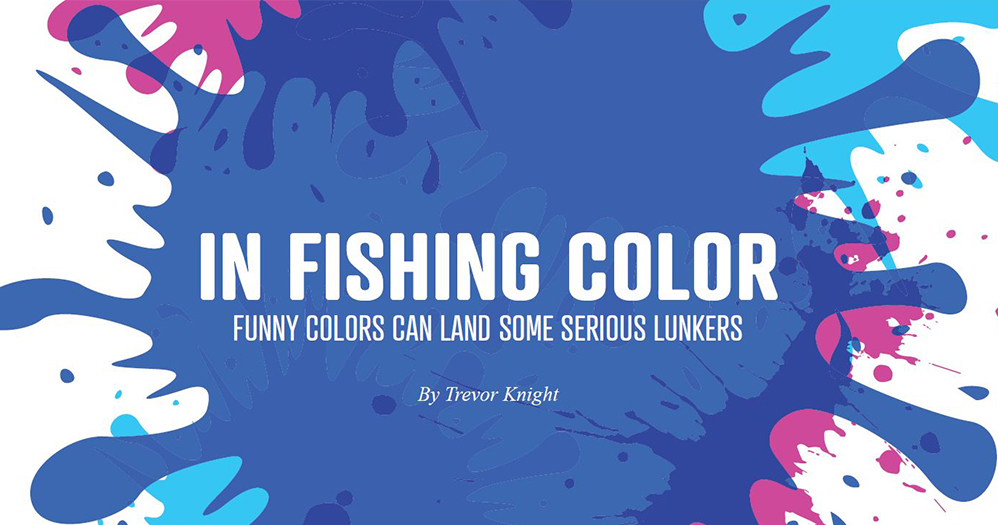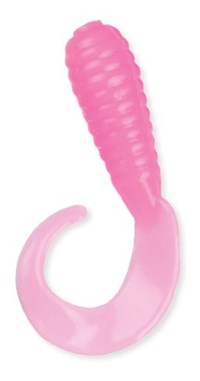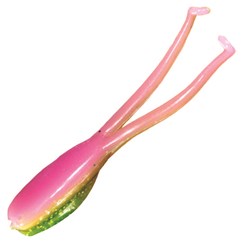In Fishing Color
7/29/2019 9:56:38 AM
By Trevor Knight

It can be a daunting task to choose the right lure when browsing the aisles of the local tackle store. Even after narrowing down the selection to a certain shape, style, and size, choosing the right color can seem like a guessing game.
BUBBLEGUM
 COLOR: Bright pink, just like the chewy candy namesake
COLOR: Bright pink, just like the chewy candy namesake
DESCRIPTION: Much in the same way that children love the candy, fish love the color of bubblegum. This color works in both muddy and clear water. It was once a secret color for many smallmouth bass anglers, but largemouth and spotted bass will bite it as well. It is an effective bass color for soft plastic baits such as stick-baits, soft jerkbaits, trick worms, and swimbaits. It can also be useful with hard baits such as jerkbaits, topwaters, spinnerbaits, and crankbaits. Crappie anglers will sometimes use bubblegum colored crankbaits or soft plastics on jigs too.
EFFECTIVENESS: So why would fish bite something bright pink? In muddy water, bubblegum actually gives off a bright glow that appears more white than pink. Bright colors have always been popular in muddy water because they show up really well to the fish. One has to realize that the way a human perceives a color out of water is not necessarily the same way a fish perceives the same color underwater looking up at the bright background of the sky. Because red is the first color of the visible light spectrum to disappear underwater, the color bubblegum may appear as more of a white or grey color when a lure gets close to 15 feet deep. For an angler, bubblegum is an easy color to see in shallow water, making it easier to detect a bite.
ELECTRIC CHICKEN
 COLOR: Yellowish green (chartreuse) combined with bright pink and some silver glitter
COLOR: Yellowish green (chartreuse) combined with bright pink and some silver glitter
DESCRIPTION: With this combination of effective colors, it is understandable why it works. The color has always been most popular with saltwater anglers and crappie anglers. The color is most often used on soft plastics like crappie grubs, crap-pie shads, swimbaits, and soft jerkbaits.
EFFECTIVENESS: The water in many inshore saltwater areas tends to be stained to muddy. Many of the best crappie fisheries have similar water. Crappie anglers typically like pink or chartreuse jigheads. Therefore, it makes sense that combining those colors would be effective. Electric chicken simply stands out in dirty water, making it easier for fish to find it.
CLOWN
 COLOR: Chrome body (sometimes with a white belly), a yellowish gold back, and a red or metallic red nose/head
COLOR: Chrome body (sometimes with a white belly), a yellowish gold back, and a red or metallic red nose/head
DESCRIPTION: With that color description, one can understand how it got the name clown. The color is most often used on hard jerkbaits and topwater lures.
EFFECTIVENESS: Jerkbaits and topwater lures often mimic dying baitfish, which explains why the color is popular with those styles. Many baitfish have a silver coloration, which is represented by the chrome. Some baitfish, such as golden shiners and threadfin shad, can have some yellow or orange coloration on their fins or body, so yellowish gold is used. The red mimics an injured baitfish that is bleeding. For these reasons, clown is a serious color consideration.
MORNING DAWN
 COLOR: Combination of translucent pink, translucent purple, a faint touch of blue, and maybe some fuchsia glitter
COLOR: Combination of translucent pink, translucent purple, a faint touch of blue, and maybe some fuchsia glitter
DESCRIPTION: It looks just like a morning sunrise when there is a little bit of cloud cover. This color is most popular with finesse soft plastics such as finesse worms, Ned worms, dropshot baits, and soft stickbaits. It has been gaining popularity with hard baits such as jerkbaits, topwaters, and spybaits.
EFFECTIVENESS: This lure color is extremely effective when fishing deep, clear lakes with red clay banks. It gained fame with spotted bass anglers in northern Georgia and South Carolina. In Mississippi, Bay Springs Lake is a prime place to use this color. Another lake nearby, that has the same characteristics, is Lewis Smith Lake in northwest Alabama. Given that this color excels on deep, clear lakes with spotted bass, it should not be a surprise that finesse baits are the most popular choices for the color. It is hard to say exactly why spotted bass love this color so much, but the main point is that it works. It will also catch largemouth and smallmouth bass if they are present.
MERTHIOLATE
 COLOR: Fluorescent reddish orange (it al-most hurts the eyes)
COLOR: Fluorescent reddish orange (it al-most hurts the eyes)
DESCRIPTION: Easily the gaudiest color on the list, this color is typically seen with soft plastic straight tail worms and stick-baits. It can also be found with some crap-pie soft plastics, although manufacturers may have it under a different color name.
EFFECTIVENESS: It is really only effective seasonally. The main use for this color is sight fishing for bass in the spring. It is most effective at catching male bass during the spawn or post spawn. During this time of the year, male bass are aggressively defending their nests. This bright color plays on that aggressiveness and is easy for an angler to see. When that bright color disappears, an angler knows a fish has it. Crappie anglers will sometimes use this color because it shows up well in muddy water. Fluorescent orange has always been popular with crappie anglers.
One could certainly argue that anglers only need four colors to catch fish anywhere they go. While black and blue, watermelon red, green pumpkin, and chartreuse should always have a place in an angler’s arsenal, sometimes it pays to think outside the box. Consider trying one of these wild colors the next time you are wandering the aisles of the fishing department. It never hurts to be a little colorful.









